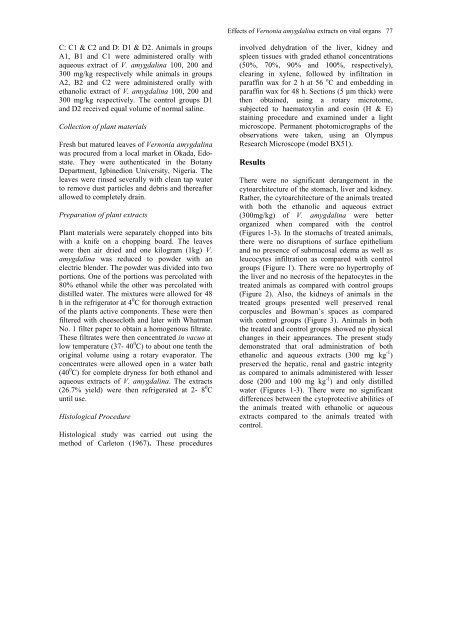Vol 9 No1 - Journal of Cell and Molecular Biology - Haliç Üniversitesi
Vol 9 No1 - Journal of Cell and Molecular Biology - Haliç Üniversitesi
Vol 9 No1 - Journal of Cell and Molecular Biology - Haliç Üniversitesi
Create successful ePaper yourself
Turn your PDF publications into a flip-book with our unique Google optimized e-Paper software.
C: C1 & C2 <strong>and</strong> D: D1 & D2. Animals in groups<br />
A1, B1 <strong>and</strong> C1 were administered orally with<br />
aqueous extract <strong>of</strong> V. amygdalina 100, 200 <strong>and</strong><br />
300 mg/kg respectively while animals in groups<br />
A2, B2 <strong>and</strong> C2 were administered orally with<br />
ethanolic extract <strong>of</strong> V. amygdalina 100, 200 <strong>and</strong><br />
300 mg/kg respectively. The control groups D1<br />
<strong>and</strong> D2 received equal volume <strong>of</strong> normal saline.<br />
Collection <strong>of</strong> plant materials<br />
Fresh but matured leaves <strong>of</strong> Vernonia amygdalina<br />
was procured from a local market in Okada, Edostate.<br />
They were authenticated in the Botany<br />
Department, Igbinedion University, Nigeria. The<br />
leaves were rinsed severally with clean tap water<br />
to remove dust particles <strong>and</strong> debris <strong>and</strong> thereafter<br />
allowed to completely drain.<br />
Preparation <strong>of</strong> plant extracts<br />
Plant materials were separately chopped into bits<br />
with a knife on a chopping board. The leaves<br />
were then air dried <strong>and</strong> one kilogram (1kg) V.<br />
amygdalina was reduced to powder with an<br />
electric blender. The powder was divided into two<br />
portions. One <strong>of</strong> the portions was percolated with<br />
80% ethanol while the other was percolated with<br />
distilled water. The mixtures were allowed for 48<br />
h in the refrigerator at 4 0 C for thorough extraction<br />
<strong>of</strong> the plants active components. These were then<br />
filtered with cheesecloth <strong>and</strong> later with Whatman<br />
No. 1 filter paper to obtain a homogenous filtrate.<br />
These filtrates were then concentrated in vacuo at<br />
low temperature (37- 40 0 C) to about one tenth the<br />
original volume using a rotary evaporator. The<br />
concentrates were allowed open in a water bath<br />
(40 0 C) for complete dryness for both ethanol <strong>and</strong><br />
aqueous extracts <strong>of</strong> V. amygdalina. The extracts<br />
(26.7% yield) were then refrigerated at 2- 8 0 C<br />
until use.<br />
Histological Procedure<br />
Histological study was carried out using the<br />
method <strong>of</strong> Carleton (1967). These procedures<br />
Effects <strong>of</strong> Vernonia amygdalina extracts on vital organs 77<br />
involved dehydration <strong>of</strong> the liver, kidney <strong>and</strong><br />
spleen tissues with graded ethanol concentrations<br />
(50%, 70%, 90% <strong>and</strong> 100%, respectively),<br />
clearing in xylene, followed by infiltration in<br />
paraffin wax for 2 h at 56 o C <strong>and</strong> embedding in<br />
paraffin wax for 48 h. Sections (5 μm thick) were<br />
then obtained, using a rotary microtome,<br />
subjected to haematoxylin <strong>and</strong> eosin (H & E)<br />
staining procedure <strong>and</strong> examined under a light<br />
microscope. Permanent photomicrographs <strong>of</strong> the<br />
observations were taken, using an Olympus<br />
Research Microscope (model BX51).<br />
Results<br />
There were no significant derangement in the<br />
cytoarchitecture <strong>of</strong> the stomach, liver <strong>and</strong> kidney.<br />
Rather, the cytoarchitecture <strong>of</strong> the animals treated<br />
with both the ethanolic <strong>and</strong> aqueous extract<br />
(300mg/kg) <strong>of</strong> V. amygdalina were better<br />
organized when compared with the control<br />
(Figures 1-3). In the stomachs <strong>of</strong> treated animals,<br />
there were no disruptions <strong>of</strong> surface epithelium<br />
<strong>and</strong> no presence <strong>of</strong> submucosal edema as well as<br />
leucocytes infiltration as compared with control<br />
groups (Figure 1). There were no hypertrophy <strong>of</strong><br />
the liver <strong>and</strong> no necrosis <strong>of</strong> the hepatocytes in the<br />
treated animals as compared with control groups<br />
(Figure 2). Also, the kidneys <strong>of</strong> animals in the<br />
treated groups presented well preserved renal<br />
corpuscles <strong>and</strong> Bowman’s spaces as compared<br />
with control groups (Figure 3). Animals in both<br />
the treated <strong>and</strong> control groups showed no physical<br />
changes in their appearances. The present study<br />
demonstrated that oral administration <strong>of</strong> both<br />
ethanolic <strong>and</strong> aqueous extracts (300 mg kg -1 )<br />
preserved the hepatic, renal <strong>and</strong> gastric integrity<br />
as compared to animals administered with lesser<br />
dose (200 <strong>and</strong> 100 mg kg -1 ) <strong>and</strong> only distilled<br />
water (Figures 1-3). There were no significant<br />
differences between the cytoprotective abilities <strong>of</strong><br />
the animals treated with ethanolic or aqueous<br />
extracts compared to the animals treated with<br />
control.

















